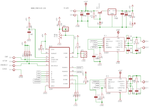edmundopt
Newbie level 4
Hello all
this is my first post, hopefully in the correct section!
I've finish reading the book "Electronics for dummies", so only basic basic knowledge
I've visited this site and found this schematic

The curious part about it is this :

I've simulate the circuit using Proteus Isis and it works , but I do not understand how, its a NPN transistor and it's being used as a PNP, is that a mistake, or it works on the real world ?
Also, using VCE = 40-12 = 28volts
It would mean that:
P = 28 volts * 0.5 amps = 14Watts, so it would get very very hot right ?
this is my first post, hopefully in the correct section!
I've finish reading the book "Electronics for dummies", so only basic basic knowledge
I've visited this site and found this schematic

The curious part about it is this :

I've simulate the circuit using Proteus Isis and it works , but I do not understand how, its a NPN transistor and it's being used as a PNP, is that a mistake, or it works on the real world ?
Also, using VCE = 40-12 = 28volts
It would mean that:
P = 28 volts * 0.5 amps = 14Watts, so it would get very very hot right ?
